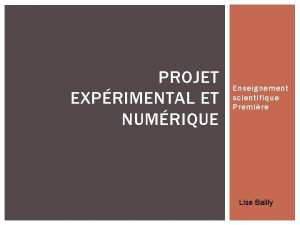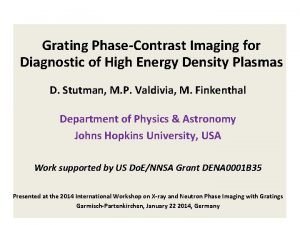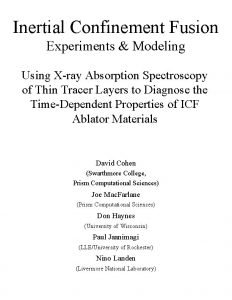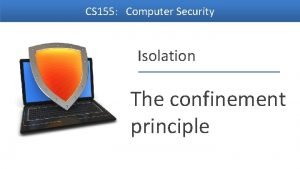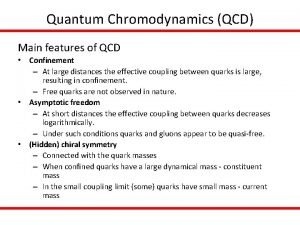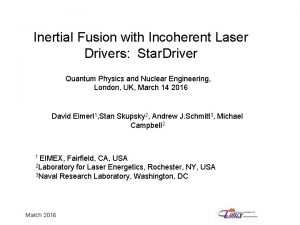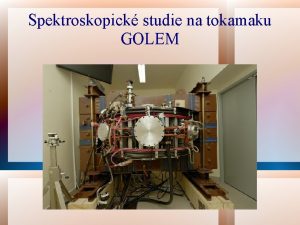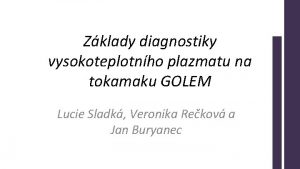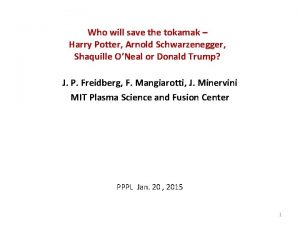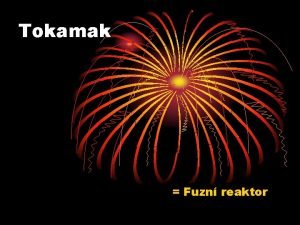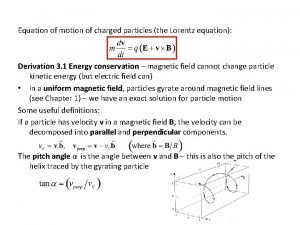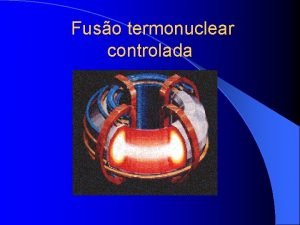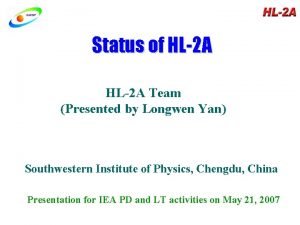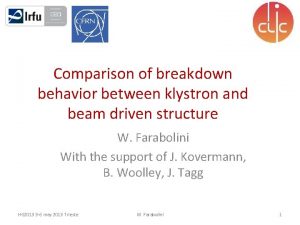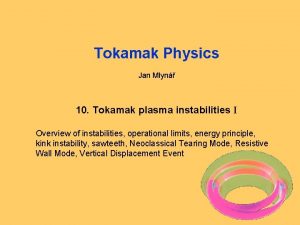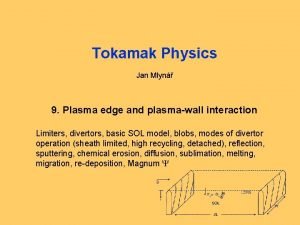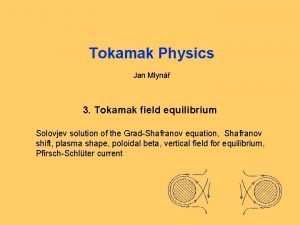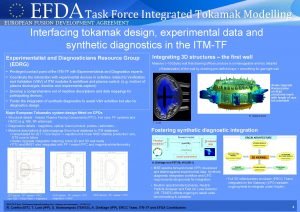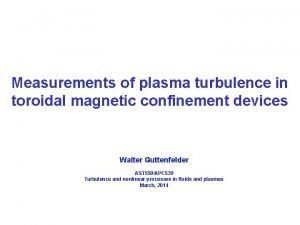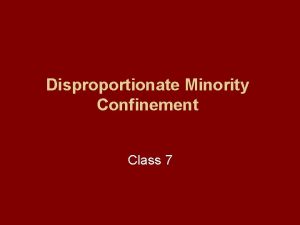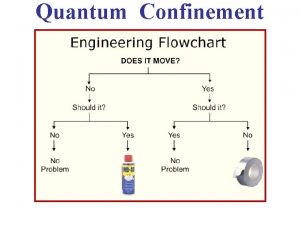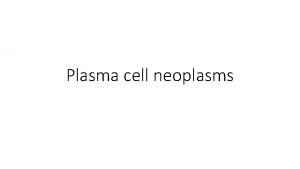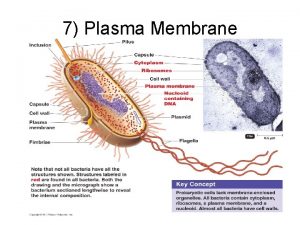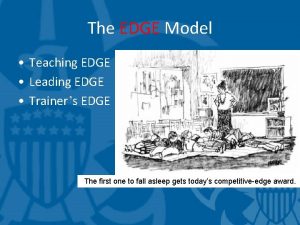Tokamak nearly perfect magnetic confinement Edge plasma is






















- Slides: 22

Tokamak: nearly perfect magnetic confinement Edge plasma is determined by balance of parallel (simple) and radial (turbulent) transport r

What radial transport? Number of particles crossing a particular surface Convection Diffusion is weak Due turbulence, but how to quantify it? rad ial collisions toroi dal

Motivation • Radial particle transport is much higher than due to collisions – anomalous • Edge modeling of tokamaks is done by non-turbulent codes that use ad-hoc values for the radial transport. • Turbulence is claimed to be responsible but no model was demonstrated yet to really quantitatively agree with experiment 3

TCV tokamak geometry 4

Experimental set-up for diagnosing edge turbulence in tokamak TCV • Reciprocating Langmuir probe = the first ever diagnostic to explore plasma • Measures fast and locally electric potential, plasma density, temperature, turbulence-driven radial particle flux, parallel flows, velocities, … Plasma Nobel prize 1932 Destroyed by ECRH X 2! Probe head Vfl Merci: R. Pitts, Ph. Marmillod, P. Lavanchy, J. -C. de Giorgi, X. Llobet, P. Conti, P. Gorgerat, R. 5 Chavan, O. Bartolomeoli Is , Te Vfl 4 1 B-field 4 mm

Jan, stop it! Let’s do something useful! The only diagnos tic inserted inside ~350 dischar ges, 100 MB / discharge L-mode Density fluctuations Slowed down 120 x 6 H-mode Discovered: ELM followed by an MHD mode potential linked to sawtooth!

First edge turbulence studies on TCV Started in 2003 Various discharges (ne, B<>0, Ip, L/H-mode, Z, D/He) Confirmed many observations from other tokamaks, e. g. : • Self-similar (fractal) behaviour • Intermittency • Time-asymmetric bursts New discovery: • Flux scales solely with density • Universality of PDF on wall • Density PDF described by Gamma 7

Analogy with a sandpile Two-parameter Gamma PDF: • mean <n> • fluctuation level A = <n>/sn A determines the shape Gamma distribution describes density PDF everywhere Graves et al. PPCF 47, L 1 (2005) Horacek et al. Czech J. Phys. (2004) Ask the Danish! Interpretation? Hmm, well … density radial 8 Jan, what about the Gamma distribution? Local sandpile height

Analogy with a sandpile model • Self-organized criticality • Jon introduced the statistics 9 Sandpile Tokamak edge Sandpile slope rp Sand grains Individual ions on Larmor orbits Force of gravity Curvature and r. Bx. B Static friction Threshold to start an instability Dynamic friction Dissipation at small scales and velocity shear Interpretation? Hmm, well …

Experiment vs. interchange model Take existing 2 D fluid ESEL model based on interchange motions: Curvature and Bx. B drift vertical charge separtion Generation of Ez Ex. B drift outwards Unstable at LFS due p Risø made the simulations, we compared with experiment. 10 Garcia, Po. P’ 05 + Gr + - B Ez Gr

The ESEL model • Electrostatic 2 D fluid model solves selfconsistently turbulence in n, Te, W. No neutrals. Garcia et al. , PRL 92, 165003 (2004); Po. P 12, 062309 (2005) • Scalar measurable inputs: TLCFS, n. LCFS, BLCFS, R+a, L|| determine the sinks (W. Fundamenski et al, Physics of Plasma 2006) • Simplifications: drift approximation, finite r. Li effects neglected, thin layer approximation (dn/n<<1, d. T/T<<1), only LFS, parallel losses in the 3 rd dimension: linear damping. Particle conservation n Energy conservation Vorticity conservation Curvature operator, 11 Advective derivative Sinks Diffusion - Parallel damping

ESEL simulation geometry 12

ESEL simulation S. J. Zweben et al, Nucl. Fusion 44, 134 (2004) 13 30 mm wall 30 mm Is it so also quantitatively? ESEL 116, particle density LCFS Qualitatively consistent with all experimental observations and theories.

Comparison with experiment • The thesis demonstrates that nearly all statistics of density, flux (and temperature) match perfectly the experiment • Most importantly, absolute level of flux matches => it describes the anomalous transport! O … Model + … Experiment 14

Summary • First edge turbulence studies on TCV • Build large database, found selfsimilarity, universality in PDF (Gamma distribution) • Demonstrated for the first time that experimental anomalous transport quantitatively agrees with interchange model (Denmark), due ( Bx. B)x. B drifts in p at LFS, dominated by rare convective blobs of ~cm size and vr~km/s. • This opens a way for quantitative predictions of plasma-wall interactions. • More scientifically in the seminar at CRPP on Wednesday 17 May, 830. 15 • First parallel flow study on TCV. • 80% of Midplane M|| is accounted by: Pfirsch-Schlütter (dominant) + ballooning (turbulence-driven) + divertor sink

2 D fluid turbulence • Re = speed* *dimension / viscosity. 16

Various analytical distributions 1. Gamma: in systems with clustering, e. g. sand-piles with avalanches [Graves Po. P 2002] 2. Lognormal: for Boltzmann-distributed electrons, ne exp(-f/Te) and Gaussian f [Sattin, Po. P 2004] 3. BHP: describes self-organized critical systems [van Milligen, Po. P 2005] 4. Gumbel: PDF of extreme values 5. Gaussian: most frequent in nature, sum of independent random processes Gamma Lognormal 17

Gamma PDF match best TCV & ESEL A = <n>/sn AT = <T>/s. T Gamma: S=2/A Log-Normal S=3/A+A-3 BHP: S=0. 9 Gumbel: S=1. 14 Gaussian: S=0 18 Functional dependence of statistical moments defines a particular PDF. Density T correlated with n at a fixed position Skewness e Temperature e Kurtosis

Density • Gradients, timescales, turbulence levels and statistical moments match 19

Flux • Cross-field turbulencedriven Ex. B particle flux • Gradients, turbulence levels and statistical moments match for flux 20 Inside LCFS experiment not reliable due pins too far

Coherently averaged density bursts match • Isolate large bursts, normalize, average them and fit by exp(-t/t+-) • Time-scales and asymmetry match • Inter-burst period match => even blob generation is well modelled => no additional mechanism needed 21 t- t+

Dissipation and parallel loss estimates Transport coefficients based on • neo-classical collisional perpendicular transport: D┴n~D┴T~D┴W~10 -3 m 2 s-1. • classical parallel transport: s. T~sn=s. W~Lc/cs~1/250 ms Taken to be constants in space and time with abrupt changes at LCFS and wall W. Fundamenski et al, Physics of Plasma 2006 22
 Projet enseignement scientifique
Projet enseignement scientifique Inertial confinement
Inertial confinement Inertia xray
Inertia xray Confinement principle in computer system security
Confinement principle in computer system security Qcd confinement
Qcd confinement Solitary confinement effects
Solitary confinement effects Thomas silverstein
Thomas silverstein Inertial confinement
Inertial confinement Tokamak golem
Tokamak golem Tokamak
Tokamak Tokamak
Tokamak Tokamak hl-2m
Tokamak hl-2m Tokamak schéma
Tokamak schéma Tokamak
Tokamak Tokamak
Tokamak Tokamak működése
Tokamak működése Hl2 tokamak
Hl2 tokamak Earth is represented nearly perfect by
Earth is represented nearly perfect by Rising edge and falling edge
Rising edge and falling edge Weber magnetic
Weber magnetic Magnetic moment and magnetic field relation
Magnetic moment and magnetic field relation Force on a charged particle
Force on a charged particle Confidential
Confidential
